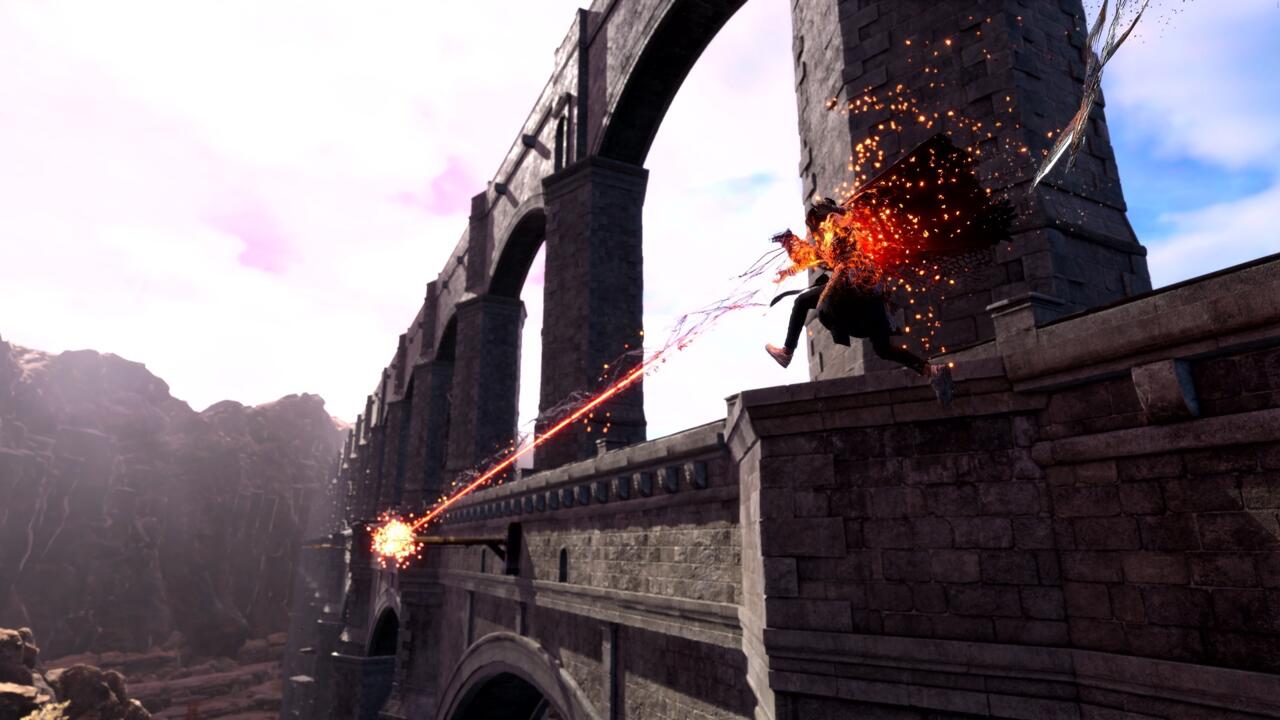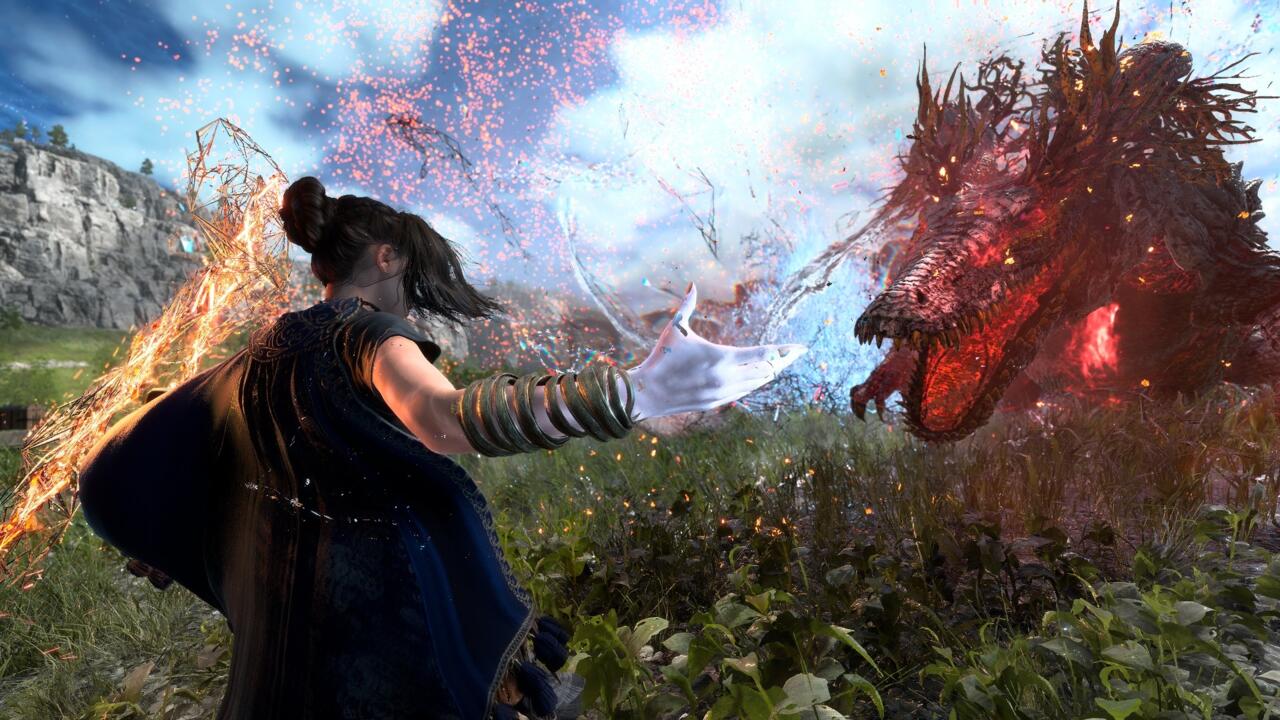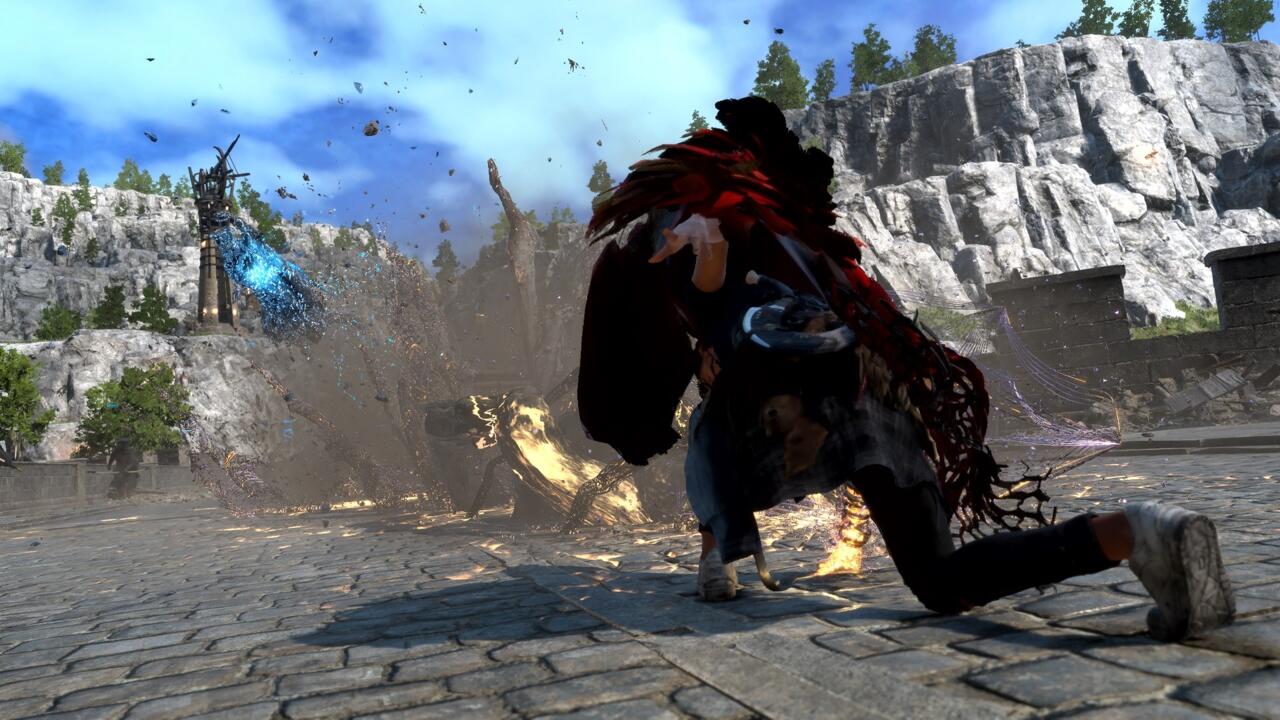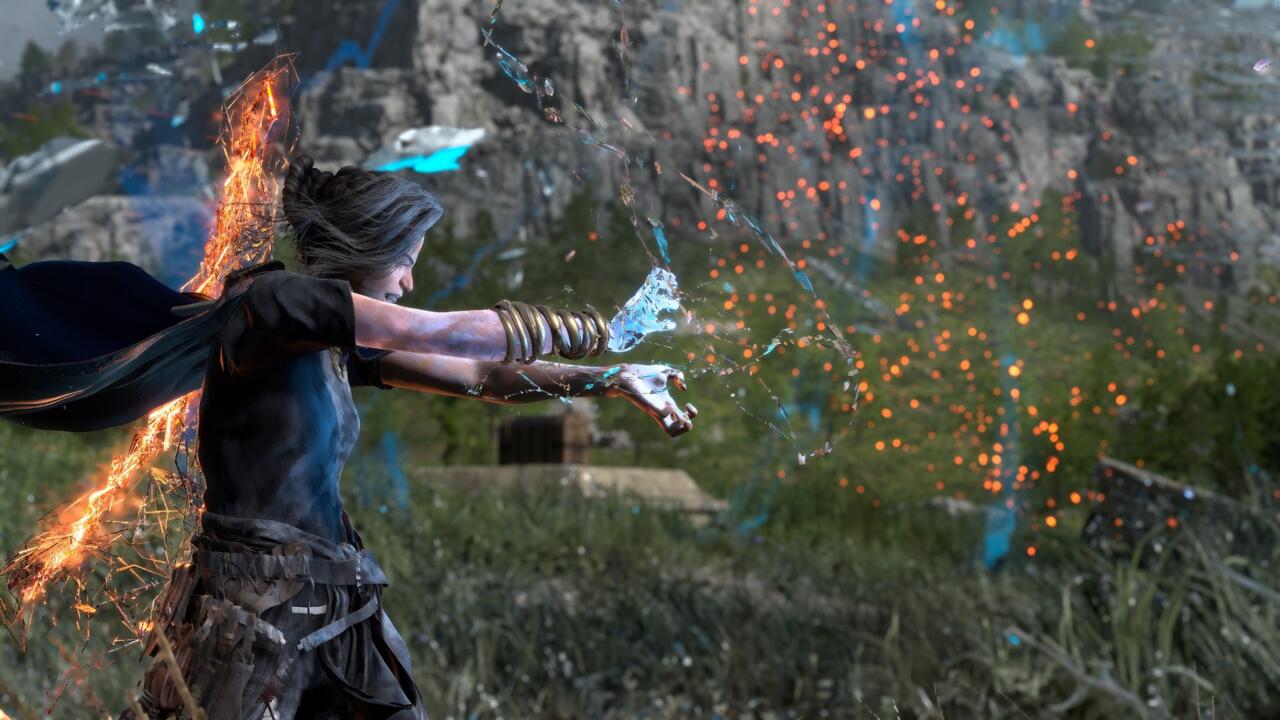If you imagine Spider-Man slinging a variety of deadly magic spells rather than webs, you have a good idea of what it's like to play Forspoken. Square Enix's upcoming open-world action game puts equal emphasis on quick movement and all manner of magical bombardments to create an experience that encourages you to think on your feet and defeat enemies with overwhelming force.
Square Enix recently gave GameSpot a chance to play about an hour of Forspoken in a curated demo. We didn't play the actual game, but rather, a specifically crafted slice that demonstrated how Forspoken will feel and also gave us a sense of how its open world will work. While the demo didn't demonstrate exactly what the full game will be like, it did give a sense of the moment-to-moment experience, how its traversal and combat systems work, and how it might stack up to similar games in the open-world genre.
Forspoken is a third-person action-adventure game set in a fantasy world called Athia. Players take on the role of Frey, a New Yorker from our world who finds herself transported to Athia. Along the way, she finds herself gaining control of powerful magical abilities, and has to fight against a corrupting force that's spreading across Athia in order to find her way home.
In some ways, what we saw of Forspoken felt familiar for anyone who's played a lot of open-world games--there were a lot of locations to unlock, small challenges to complete, and items to collect to upgrade protagonist Frey's powers. Where Forspoken stands apart is in its traversal and combat, once you get the hang of both. Especially in combat, it can be a fast and frenetic game, thanks to a huge amount of magical abilities to use against enemies. While you'll have to think about how to best use all the magic weapons at your disposal, the fun of Forspoken is in the speed--it relies less on methodical planning and more on hitting opponents with everything you've got.
The demo we played took place in a series of vast fields, craggy valleys, and swampy lowlands. Most of the time, you'll get around with Forspoken's magical parkour system, which has been a big highlight in trailers and gameplay videos so far. Holding down a single face button on your controller activates the ability, which causes Frey to bound forward and to automatically climb up or spring off any obstacles that get in her way. You can't parkour forever, though--Frey has a limited amount of stamina that has to be recharged after a while.
To get the most out of the traversal system, you want to plan your moves through the world to actually hit obstacles and use them to your advantage. For instance, just bounding across an open field will let you move fast for a short period, but you'll get farther if you cut through a stand of trees, because Frey will kick off them as she passes to get extra speed and distance. You'll also want to combine the parkour system with Frey's ability to grab onto ledges or special rocks with a sort of magical rope, which allows her to zip forward or upward like Spidey making his way up a building or across rooftops.

Everything in Forspoken is infused with magic, co-director Takefumi Terada said in an interview with GameSpot, and that's what makes the parkour system stand out from similar approaches in other games. It's not just that you bound over obstacles and perform sick flips, but that the addition of magic makes it possible to do parkour moves to cross big gaps or get large increases in speed.
Getting around in Forspoken feels pretty good, and the game keeps controls simple so that it's easy to navigate terrain fluidly. But even the demo we saw had a pretty huge open world, with a lot of space between points of interest. A fast-travel system you unlock by visiting key locations helps make it quicker and easier to get to objectives that are vastly far apart. It seems that while parkouring around the map will be a main focus of the experience, the parkour mechanics are better for shorter trips around objects--at least until you unlock more capabilities as you explore and Frey levels up. I found myself running out of steam as I tried to cross large open areas, and it took me a while to get a good sense of how to utilize the system to make getting around fun instead of arduous.
Parkour is also a big part of Forspoken's approach to combat, which is all about keeping on the move and walloping enemies with a huge amount of magic spells, and definitely contributes to an enjoyable Spider-Man-like feel. Developers at Luminous Productions say players will eventually have access to 100 spells, a daunting number that, after playing, becomes a big selling point. Instead of all those magical options becoming overwhelming, Forspoken feels like it's designed to encourage you to just try everything, casting spells as fast as you can to see what they can do and how well they can work in synergy with one another.
We saw a handful of spells in our demo, which were divided into groups based on their elements. For example, you've got Purple magic, with themes of being earth- and planet-based, and Red magic, which draw their power from fire. Under each elemental color, you've got two main spell types. Attack spells allow you to cast them over and over and are your main way of inflicting damage, taking forms like a charged-up ball of earth that explodes into enemies, or a rocky shield that blocks damage and then crashes forward in a hail of stones. We had access to three attack spells for each magic color. Support spells made up the second type and had different effects, like binding a group of enemies to a spot or calling up a projectile-launching flower to act as a turret. Support spells all have cooldown timers, but you have access to a lot of them for each magic color and can quickly swap between them on a weapon wheel, allowing you to cast several in succession as you pair them with your attack spells.

The trick in Forspoken is to use all those spells together in smart ways. Some enemies are weak against a specific magic color. Others are best handled with specific support spells--flying enemies, for instance, are tough to hit with spells that stick to the ground. So you might bind a bunch of melee fighters with Purple magic vines, then charge up a rock blast to hit all of them at once, before swapping to a Red magic flaming sword that you use to pummel them further, and finish up by throwing a fire spear that damages one enemy before exploding and hitting them all.
All the while during combat, you're using parkour to keep yourself moving, dodging incoming attacks, and earning bonuses by using spells as you're flipping through the air. Once I got the hang of the fast and hectic combat system, it quickly became my favorite part of Forspoken, and the mix of tactical thinking, fast and agile movement, and all-out magical superiority makes for an interesting mix for an action game. Flinging spells at enemies often feels like a balance between picking things you know will be effective, like binding an opponent at the perfect moment, and throwing everything and the kitchen sink at them as you quickly cycle through your options.
Having so many spells can feel a bit overwhelming at first, but it feels like Forspoken comes into its own as you start to get used to your options and begin to recognize that while strategizing which spell to use when can be important, it's not always essential. Using the right spell for the job can be great, but just battering enemies with lots of spells is fun, too.
"One of our initial goals was to implement a hundred different types of spells," Terada explained. "And we fully realize that a game can be fun and enjoyable even without that many spells present, but it was really just something that we set out in the beginning to offer. And so obviously the technical aspect of it and just the cost aspect of it, there are a lot of different challenges. And many times while we were trying to implement different things in the game, we felt like maybe it might be better if we decreased the number of spells here, but we really pushed through because we felt it was such an important aspect of the game to be able to offer all of these spells and customization options."

Fights often include lots of enemies at once, requiring you to think about how you can control crowds and move around the space to keep yourself out of danger. The demo included a few different scenarios, including a challenge location where you were tasked with defending a group of villagers from waves of enemies for a set amount of time. There were also a few bosses to fight in the demo. One was a fast-moving stag and the other was a slower but harder-hitting crocodile. Both were huge, infected with a corrupting force called the Break, and both put me through my paces of using parkour, dodging, and tons of magic to bring them down. That was especially the case against the "hidden" stag boss, which created waves of deadly energy with its antlers and bucked around, requiring a lot of quick movements and repositioning to fight.
Terada said the development team had to work to find a balance between the fast and jumpy movement of the parkour system and the third-person shooter-like feel of the spell system.
"It especially became a challenge during mid-development where we really realized that with a fun parkour system, it's really fast-paced," he said. "And one of the main, I guess, purposes of the battle, is to be able to aim for an enemy, and when you're moving so fast, it becomes really difficult to actually stop and aim at the enemy. And so our challenge and just what we are really working on became how to simplify this gaming action and make this battle experience really intuitive."
In practice, combat does end up feeling pretty intuitive--spells fire either with a single button press or hold, a pair of weapon wheels makes it pretty easy to swap between spells on the fly, and parkour is executed just as simply by holding a face button. The fun comes from your tactical awareness of the fight, your quick reflexes, and your decisions in which spell to cast; Forspoken keeps everything else pretty simple so you don't get bogged down in it.

Though combat and parkour felt great in Forspoken, other elements were tougher to get a bead on. The demo had a few open-world elements scattered around its map, including locations where you could collect power-ups, spots with challenges like the villager defense fight mentioned earlier, roaming bosses, safe houses where Frey could sleep to recoup health, and fast travel locations. A few areas had special, tough fights that required clearing out a town or specific area to earn a new cloak or a new fingernail paint set. Both of those items offer ways to change how Frey fights, providing buffs to certain kinds of magic and increases in health and defense.
The demo was largely about completing several small objectives, which gave a sense of what Forspoken's open world will be like, and these were largely of the type fans of the genre will be used to. Small challenges seem likely to be scattered all around Forspoken's world of Athia, keeping you busy for short bursts of time. The fights can be fun and interesting, but many of the elements we saw seemed pretty standard for open-world games: things like visiting a point of interest to unlock a fast travel destination, or fighting a group of monsters guarding a treasure chest, or completing timed combat challenge. The bosses were great fights, but even though the activities in the demo were fine, none of them felt like standout additions to open-world games that are going to make players sit up and take notice to these kinds of small, map-filling jobs.
Creative producer Raio Mitsuno said that Forsaken's open world is largely about maximizing its magical parkour system, but your path through it will be dictated by the story as Frey uncovers her new abilities. You won't be able to explore the whole world from the get-go, but more of it will become available as you gain new abilities. From what we saw and the sounds of things, though, you shouldn't expect a map that's smothered in waypoints and icons. We got only a taste of Forspoken's open world and the activities you'll discover within it, so we'll have to see how the game marries its narrative with the various side opportunities games like this are known for.
The other thing that we only got a small sample of was the relationship between Frey and the Cuff, the magical talking bracelet that provides her with different abilities and also acts as her traveling companion. The relationship between Frey and her enchanted jewelry seems like it's going to be a central focus in Forspoken, and as such, you're going to hear a lot of banter between them. Some of that banter comes as you travel around the world, providing context for the locations you're visiting or providing some character development. Hearing Frey and Cuff discuss the world, which seems foreign to both of them, helps make even traveling across open fields seem like it's providing something important to the game and gives the characters a lot more life.

Combat banter, on the other hand, could veer toward grating, although I didn't get a complete sense of what it might be like in the full game. Cuff tends to make dumb jokes like "Put that in your pipe and smoke it!" as you kill an enemy, for instance, and has a bit of a stuffy British demeanor. Forspoken's brand of humor has been the source of some derision thanks to a recent story trailer, and while my demo didn't include any story points, the dialogue was in keeping with that style. As two characters interacting in reaction to things happening in the world, however, it felt a lot more organic than Forspoken's trailers might suggest.
Mostly the issue was that I heard a lot of the same gags, admonishments, and complaints during my short time with the game. Here's hoping that Forspoken has more variety in these areas when it releases, since listening to Frey and Cuff talk, or fight, or compliment each other seems like a very big part of the overall experience.
The slice of Forspoken I saw didn't convey too much about the game--narrative and storytelling are a big part of the game and none of that was in the demo, for example. But the hour I played provided a sense of the fast-paced magical action at the game's heart. It takes a few minutes to get the feel for it, but once you understand what Forspoken is going for, its traversal and combat systems start to feel really great. They're simultaneously both similar to what we've seen in other open-world action games, and feel like they bring a fresh spin to the genre. The idea of slinging 100 spells against enemies, while jumping, climbing, and flipping to keep out of harm's way, is an enticing one, and Forspoken's systems seem like they'll be as fun to use as they have been to watch in trailers when the game releases in January on PlayStation 5 and PC.














